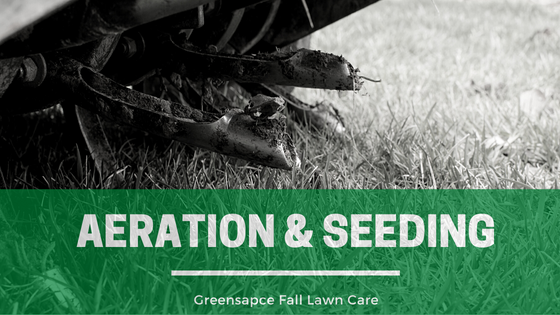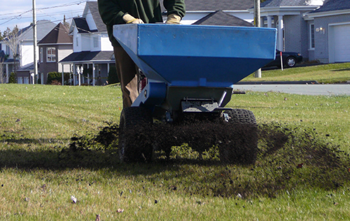
Give Your Lawn A Breather
Fall is fast approaching! September and October mean cooler weather, hopefully some consistent rainfall, and less weeds & insect activity – a.k.a. it’s the perfect time to repair your damaged lawn. So let’s talk Aeration & Seeding…

BENEFITS OF AERATION:
- Efficient absorption of water & fertilizer
- Minimize thatch
- Reduce soil compaction
- Improved lawn health & aperarance
- Ability ot withstand more activity
- Increased oxygen flow into the soil
What is Aeration?
Technically speaking, aeration is the naturally occurring process of air exchange between the soil and its surrounding atmosphere. What you probably see aeration as…. is the process of removing small plugs of thatch and soil from the lawn. The lawn care industry can also refer to it as “core aeration”. Aeration allows water, air, and nutrients to get down to the grass root, creating the foundation your lawn needs for strong regrowth in the spring.
What Is Overseeding?
Overseeding refers to the process where new grass seed is spread over an existing lawn to fill in gaps, adding thickness and color.
By overseeding newer varieties of turf grass into an older lawn, you can help it better withstand insects, disease, drought, shady conditions and heavy traffic. This approach also helps reduce the amount of water, fertilizer and pesticides needed to keep it in tip-top condition.
Aeration & Overseeding Process
Warm soils, cool nights and dying annual weeds make fall conditions the ideal time to repair your turf. An aeration, compost application, and overseeding create the perfect fall turf care combo. This sets your lawn up for enhanced root growth while giving the turf extra natural nutrients before the winter months. All of these allow for a nice early spring greenup and growth.
The first step would be aerating your lawn. The type of aeration equipment used can determine how effective the treatment will be. Turf responds best when the core holes are close and deep. Greenspace uses two different aeration machines and we typically like to penetrate the soil at a 3 inch depth. This depth however can vary depending a little due ground firmness and other safety factors taken into account when working on a specific jobsite.
Most home lawns benefit from annual aeration. Heavily used lawns, or those with lots of clay may need aeration twice a year. It’s best to aerate before pre-emergence herbicides are applied. Aerating after a herbicide application can reduce the chemical barrier formed by the herbicide, allowing weeds to germinate. Water the lawn after aeration, particularly in areas where drought and high temperatures are common.
After the aeration is complete, we will then broadcast the seed and compost mixture over the lawn. All of this will create a nice blanket to protect the seed from birds or other animals, and give a natural nutrient boost to the existing turf… setting your lawn up to be the best on the block!
What can you expect?
Immediately after aeration, your lawn will be dotted with small plugs pulled from the soil. Within a week or two, they break apart and disappear into the lawn.
About 7 to 10 days after aeration, the aerification holes will be filled with white, actively growing roots – a sign that the turf grass is receiving additional oxygen, moisture and nutrients from the soil.
On compacted soils and on lawns with slopes, you should see an immediate difference in water puddling and runoff after irrigation or rainfall. After aeration, your lawn should be able to go longer between waterings, without showing signs of wilt. With repeat aerations over time, your lawn will show enhanced heat and drought stress tolerance.
Remember, most lawns benefit from annual aeration. And while you shouldn’t expect miracles, especially with poor soil, lawns that receive this care will be healthier, more vigorous, easier to maintain and have fewer pest problems. For other fall tips, check out the Iowa State Extension Office’s Fall Tips to Ensure a Healthy Green Yard for Spring.
If you don’t receive lawn care services from us currently, and/or are interested in receiving a proposal for this service, please send us a message or give us a call (563)355-8148.

Thanks again!